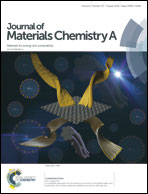A renewable wood-derived cathode for Li–O2 batteries†
Abstract
In this work, we developed a renewable wood-derived cathode with well-aligned elongated microchannels for high-performance Li–O2 batteries. The cathode was obtained from natural wood following carbonization, activation, and then loading of RuO2 nanoparticles (4.15 wt%) as catalysts (RuO2/WD-C). The cathode has a three-dimensional, high stability carbon matrix, uniformly anchored catalysts, and well-aligned porous microchannels. As a result, the specific areal capacity of the assembled batteries exceeds 8 mA h cm−2 and the charge terminal potential is lower than 3.8 V at 0.1 mA cm−2. The energy efficiency was improved up to 91.9% and exceeded 87.1% after 100 cycles (curtailed capacity of 0.5 mA h cm−2 at 0.2 mA cm−2). Furthermore, the RuO2/WD-C cathode can be fully regenerated from a deep discharge–charge cycle or 100 curtailed-capacity cycles by simply washing with water. The areal capacity of the regenerated RuO2/WD-C cathode is comparable to the performance of the initial cathode. The cut-off voltage was above 2.6 V following 200 cycles. Even when regenerated for the second time, the RuO2/WD-C cathode still demonstrated almost the same high performance as the initial one, indicating its high stability and excellent renewability.



 Please wait while we load your content...
Please wait while we load your content...